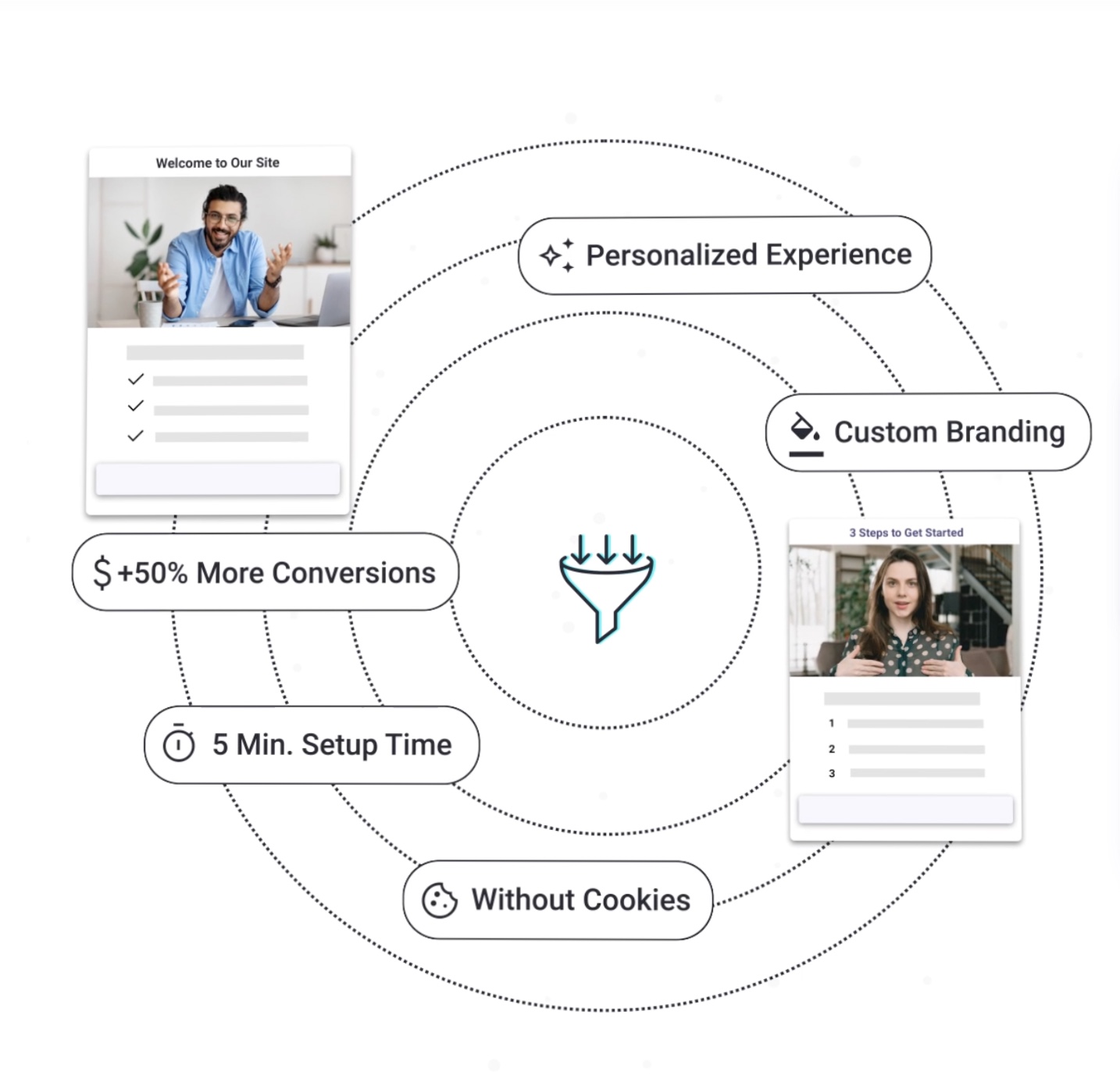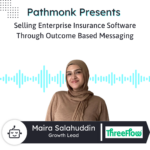
Introduction
Join us as we sit down with Caleb Clark, Chief Partnership Officer and Co-founder of Hook and Ladder Digital.
In this insightful episode, Caleb shares his expertise on transforming underperforming marketing systems into profitable business drivers. Learn about the importance of investing in talent, creating a world-class work environment, and implementing open-book management. Discover strategies for effective client acquisition, website optimization, and content creation.
Don’t miss this opportunity to gain insights from a seasoned digital marketing expert.
More Sales From Your Website With AI
Personalized interactions based on your users' behaviour to get +50% more conversions.

Ernesto Quezada: Pathmonk is the intelligent tool for website lead generation. With increasing online competition, over 98% of website visitors don’t convert. The ability to successfully show your value proposition and support visitors in their buying journey separates you from the competition online. Pathmonk qualifies and converts leads on your website by figuring out where they are in the buying journey and influencing them in key decision moments. With relevant micro experiences like case studies, intro videos, and much more, stay relevant to your visitors and increase conversions by 50%. Add Pathmonk to your website in seconds. Let the AI do all the work and get 50% more qualified leads while you keep doing marketing and sales as usual. Check us out on pathmonk.com. Welcome to today’s episode. Let’s talk about today’s guest. We have Caleb, Chief Partnership Officer and Co-founder at Hook and Ladder Digital. How are you doing today, Caleb?
Caleb Clark: I’m good, I’m good. Thanks for having me.
Ernesto: It’s great to have you on. I’m excited to learn a little bit more about Hook and Ladder. Well, let’s kick it off with that then, right? Caleb, in your own words, tell us a little bit more.
Caleb: We’re a digital marketing company that works with organizations that have underperforming marketing systems. That underperformance shows up as a cost center, and it’s directly tied to a capacity or expertise constraint they have. We believe that when you have the right team in place, both the headcount and the corresponding expertise, marketing systems can be virtually guaranteed in terms of success. So we solve a resourcing problem. We develop and deploy cross-functional, scalable teams of digital marketing experts that become an integrated extension of our clients’ organization and become their digital marketing department.
Ernesto: Perfect. Awesome. Thank you so much for sharing that. And so that way our listeners can get a good understanding of Hook and Ladder Digital. What would you say is the key problem that you guys like to solve for clients?
Caleb: Marketing systems that exist within organizations, where the leader, either the CEO or the marketing leader, is frustrated because the accountability of the marketing system is tied too much to activities, not to business outcomes. There’s a concern that it is an ongoing cost center with no line of sight towards business impact and outcome. That’s ultimately the biggest concern. We’re doing a lot of things, but we don’t really know if it’s creating anything of meaningful value.
Ernesto: Definitely. I think that’s a concern for a lot of companies, so it’s awesome to hear that Hook and Ladder is tackling that. Is there a certain vertical, or an ideal ICP for you guys that you like to go for?
Caleb: From an industry standpoint, we’re agnostic by choice and by design. But the common criteria are that it’s an established organization with a long history of product-market fit, lots of customers, they’re in aggressive growth mode, and they have a very lean internal marketing team of four or fewer people. The final criteria is that they are looking for a long-term collaborative partnership as compared to one-off projects here and there.
Ernesto: Okay, perfect. Great to hear that. So, on that note, how would they usually find out about Hook and Ladder? Is there a top client acquisition channel for you guys?
Caleb: Our top client acquisition channel, although not consistent, is variable. It’s, of course, the advocacy of our happiest clients and strongest network. But the second one, and the most active one, is our content creation through podcasts and LinkedIn thought leadership content, snackable pieces of content that are tied to a value resource that we give access to, not gated. We run a podcast where we explore the biggest pains and frustrations of marketing leaders and then provide a solution if necessary.
Ernesto: Definitely. I think that’s one of the reasons why we contacted you, because you’re an expert on that. So I’m glad that we were able to connect. And so that way our listeners who are tuned in can go ahead and visit you. They can always check you out at hldigital.ca. What role does a website play for client acquisition, Caleb?
Caleb: Well, I think it plays obviously a critical role. There are a lot of different ways to answer this, but the way I perceive it is that it’s a place that allows people to very clearly understand what problems you solve, for whom, and why you’re best suited to solve them. I think a website is critical in drawing a very specific and distinct line between who we are not for and who we are for. I think it creates a great opportunity to see that others have trusted you and that I, as a prospect, don’t have to be the first one to try to trust you. So I think social proof and trust signals are incredibly important. And finally, I think it needs to get out of the way of people trying to fulfill their transformation from a non-ideal before-state to an ideal after-state. I think websites over time have become calloused with lots of different layers, pages, information, and text. I think the website’s job is to clearly show what problem you solve for whom, and make people feel that they’ve arrived where they need to be, and then at the same time, get out of the way and allow them to fulfill their user journey. Good CTA placement, great CRO—ongoing CRO is required to be able to map the infrastructure of your site to the ever-evolving desires, needs, and preferences of users. That’s my philosophy on it in a nutshell.
Ernesto: That’s important. So on that note, Caleb, are there any tools, tips, or methods that you would recommend to our listeners as far as website lead generation?
Caleb: Yeah, I think consistent effort or at least thought process around UI, UX, customer conversion rate optimization—just putting yourself in the shoes of the user and helping get things out of the way by having a perspective shift of your audience. And then a couple of things that I’d like to hone in on are social proof and trust signals. I think it’s really important that people feel that others like them are in the same boat and that you have demonstrated a successful transformation for them. So finding unique ways to show advocacy, to show testimonials—they don’t have to be classic testimonials, but something that proves to them that they don’t have to be the first to experience you. There are others that have come before. As for tools, I’m not actually a very technical marketer. We have a strong website team, but I think when there’s an exploration around different plugins and tools, they should all be evaluated through the lens of: Does this make my users’ experience better or worse? And then make the judgment based on that.
Ernesto: Absolutely important. Well, thank you so much for those tips and methods. And well, Caleb, let’s switch gears a little bit and talk about you as a leader. You being the co-founder and Chief Partnership Officer at Hook and Ladder Digital, what are some key tasks you like to work on a daily basis?
Caleb: In terms of improving myself as a leader or what I do to help grow Hook and Ladder Digital? Well, it’s gone in phases. We launched in 2011, and for the first five or six years, it was kind of a four-person shop. The biggest, best decision I made, along with my co-founder, was to invest in talent and people and allow these people to grow into whatever their version of potential fulfillment is—leadership opportunities. We focus almost exclusively on being a world-class place to work. We have a very strong process and set of systems for establishing strong bench talent, allowing them to graduate to whatever their version of growth looks like. And then just pivoting to making sure that our job, and my job along with my co-founders, is to keep the main thing the main thing—keep communicating with the North Star, where we’re trying to go, what is our mission, our purpose—but not then go into the next step, which is telling them here’s how to do it. So making the main thing the main thing and making that publicly available and often repeated, but then trusting in the very unique expertise and experience of our team to establish how we’re going to do it.
The last thing I’ll say is from a decision standpoint, our best decision is we adopted the Great Game of Business methodology where essentially we open the books, the P&L statement to everybody on the team. We assign ownership of different lines, like revenue lines or expense lines, to different members of the team so they can own those, report on them, and forecast against them. And then, carve out a certain percentage of profits and make that available for everybody to benefit from the gain. So creating an organization of owners. What I do on a day-to-day is look out for new partnership opportunities, whether that be clients or partners, outside of being a client, and look to grow the top line. That’s my job today.
Ernesto: Sounds like you have a full plate on your hands. I mean, after twelve years, still going strong. Awesome to hear that from you, Caleb. So in the between times, when you do have some spare time, how do you stay up to date with all the marketing news and trends out there? Is there a preferred channel that you like to go with?
Caleb: I like to use our internal communications channel. We use Google Chat, and then another tool called Gather, and then Monday. I just try to jump in on meetings or discussions as an observer because I think that the experts that we have on our team are dedicating a majority of their time to digging into these things, and I like to hear from their perspective. So that’s my usual professional development in the disciplines of marketing—just being a fly on the wall for the people on our team much more qualified than I am in these areas. And then, a specific group that we’ve partnered with for a long time is Digital Marketer, run by Ryan Dice. They have amazing guides, tools, lessons, and checklists just to keep top of mind. So I do few things, but I go deep on those few things—digitalmarketer.com and exploring the conversations happening internally at our organization.
Ernesto: Definitely. That goes back to what you mentioned, right? Invest in talent so they can go ahead and give you the best options. Awesome to hear that from you, Caleb. Well, let’s jump into our next section here, which is our rapid-fire question rounds. Are you ready for them?
Caleb: Sure.
Ernesto: Awesome. First off, Caleb, what is the last book that you read?
Caleb: The last book that I read would have to be The Soul of Money. Revisiting and exploring your relationship with money, good or bad. I think, depending on our upbringing individually, we have a different relationship with money, and that can trickle into how we sell, how we do our marketing activities and campaigns. So that’s an interesting one—The Soul of Money.
Ernesto: Okay, a great read there for our listeners. Next up then, if there were no boundaries in technology, what would be the one thing that you would want to have fixed for your role as a marketer today?
Caleb: I think a lot of times we feel like we’re working for the algorithm, not working for our customers or our target market. So something that allows us to untether ourselves from how the algorithm wants to optimize our campaigns or systems, but more focused on really, really tight and dialed-in relevant targeting—not just from a demographic standpoint, but a scenario-based or psychographic standpoint. So, better targeting to more relevance and less reliance on Meta algorithms, Google algorithms, etc.
Ernesto: Okay, perfect. Thank you so much for that. Next up then, if there’s one repetitive task that you could automate, what would that be?
Caleb: One repetitive task that could be automated—what would that be? That’s a tough one because copywriting is the most, I think, unheralded and underappreciated task. Copywriting is such magic when done right, but there are certain scenarios where there’s production copy that is just pumping out copy based on an already defined strategy and framework, and then there’s net-new copy in my mind. So I think for some of that production copy work that’s already influenced and informed by a dialed-in strategy, it would be nice to automate some of that from my perspective. I think automating website usability and user flow, UI/UX conversion rate optimization—I think that’s interesting because I haven’t heard of a lot of ways to automate that successfully. It’s usually a manual effort with a lot of time required, invested in building that plan. So I think that would be a—I’m just realizing now that’s a bit of a plug here, but that is truthfully what I think is important.
Ernesto: Yep, definitely. Thank you so much for that. And well, lastly, Caleb, you have a lot of experience already in the marketing world, but what is that one piece of advice that you would give yourself if you were to restart your journey as a marketer today?
Caleb: Double the impact with half the effort. Do way fewer things, but do them deeper. And those fewer things, just make sure that there is an undeniable linear relationship between those activities and the business case. Less focus on doing things for the sake of doing them—to optimize for impressions, engagement, and growth—but to actually solve a business case. So I would do way, way, way fewer things and just do them simpler and deeper. I would build our strategy on a napkin as compared to a 15-page document. I wish I could have done that, but alas, here we are.
Ernesto: No, but it’s some great advice, right? For our listeners, someone who’s starting off, I mean, that’s valuable insight. Thank you so much for sharing that with us, Caleb. And well, we are coming to the end of the show today, but before we do end, I do want to give you the last word. So say someone forgets everything about the interview today, what is the one thing they should remember about Hook and Ladder Digital?
Caleb: The only reason that I’ve found that marketing systems fail is because the right team does not exist. So when you can solve the resourcing problem effectively and profitably, then you can solve the marketing underperformance problem, which then allows you to solve the business objective problem—turning marketing from a cost center into an area of predictable and profitable return. Solve the resourcing problem.
Ernesto: Awesome. Great advice there. Well, Caleb, I do appreciate you being on with us today. To our listeners, check them out at hldigital.ca. They are your digital marketing department and business extension. Caleb, thank you so much for being on with us. To our listeners, thank you so much for tuning in, and I’m looking forward to our next episode at Pathmonk Presents. Thanks a lot, Caleb.
Caleb: Appreciate it.











